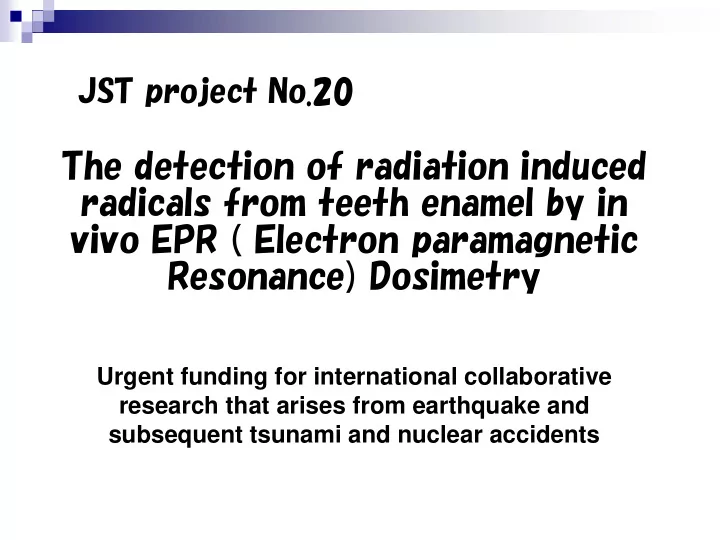

JST project No.20 The detection of radiation induced radicals from teeth enamel by in vivo EPR ( Electron paramagnetic Resonance) Dosimetry Urgent funding for international collaborative research that arises from earthquake and subsequent tsunami and nuclear accidents
Japanese Research Team Minoru Miyake 1 , Ichiro Yamaguchi 2 , Michitaka Umakoshi 1 , Hiroshi Hirata 3 , Naoki Kunugita 2 , Yoshiro Matsui 1 , Akinori Iwasaki 1 1 Department of Oral and Maxillofacial Surgery, Faculty of Medicine, Kagawa University, Kita-gun, Japan 2 Department of Environmental Health, National Institute of Public Health, Wako, Japan 3 EPR group in the Division of Bioengineering and Bioinformatics, Hokkaido University, Sapporo, Japan
US Research Team Dartmouth Medical School, Department of Harold M.Swartz Professor MD, PhD Radiology and Medicine (研究者) Benjamin B. Williams Dartmouth Medical School, Department of Assistant PhD Radiology and Medicine Professor Stwarts, Steven G. Unversity of Florida Professor PhD Flood, Ann B. Dartmouth Medical School Professor PhD Duinan, Eva C. Dana Farber Cancer Institute Professor MD Hyde, James S. Medical college of Wisconsin Professor PhD Dartmouth Medical School, Department of Associate Lesniewski Piotr M.S.E. Radiology and Medicine Professor
AI AIM: T : To es o establi tablish h the the technique ues s for i in-vi vivo vo Dos osimetry etry i in J Jap apan an that can that can provi rovide de stable and table and reproduc ucible EP EPR m measur surements s in con connecti nection on wi with th unp nplan lanned ned radi radiati ation on exp expos osures res, i in collaborati n collaboration on wi with the th the US team S team. This project includes following issues ; 1)Develop techniques to make the measurements using the incisors (extending in Japan the capabilities that previously were for premolar or molar teeth) 2)To make measurements from upper incisor with volunteers who live in FUKUSHIMA
The problems on “lying down” position 1. Uncomfortable, because saliva easily accumulate in the deep of the throat. 2. It is difficult to firm fixation of the detector loop on molar or premolar. 3. Limited field of view between the magnet at the lying down position makes the volunteer nervous or anxious . We developed “incisor measurement on the sitting position supported by Dart-Dose CMCR and installed in the clinical system in NIPH.
A wooden frame containing no magnetic materials was made for firmly but comfortably holding the head of volunteers sitting in a chair during the measurement. The resonator is held on the distal end of a lockable articulating arm that is mounted to wooden frame.
Lying down measurement Sitting measurement y 6.00E-02 1.50E-01 y 4.00E-02 1.00E-01 -6.50E+00 2.00E-02 5.00E-02 -6.48E+00 0.00E+00 -6.45E+00 -1.00E+01 -5.00E+00 0.00E+00 5.00E+00 1.00E+01 1.50E+01 2.00E+01 0.00E+00 -2.00E-02 -6.43E+00 -1.00E+01 -5.00E+00 0.00E+00 5.00E+00 1.00E+01 1.50E+01 2.00E+01 -5.00E-02 -6.40E+00 -4.00E-02 -6.38E+00 y -1.00E-01 -6.00E-02 -6.35E+00 -8.00E-02 -6.33E+00 -1.50E-01 -6.30E+00 -1.00E-01 -2.00E-01 -6.28E+00 -1.20E-01 -2.50E-01 -6.26E+00 -1.40E-01 Noise Peak lying down Signal intensity (a.u.) 0.5 0.45 sitting 0.4 0.35 lying down sitting 0.3 0.25 Noise mean 0.278 0.118 0.2 0.15 SD 0.093 0.044 0.1 0.05 SN(PDT)ratio 1.21 2.03 0 1 2 3 4 5 field 計測点
Materials and Methods Fukushima Daiichi Nuclear Plant 35 volunteers were enrolled in this study (male 15, Female 18, Date Som Fukushima a average age was 25 years). All Itate Minami volunteers had at least one Soma Nihonmatsu complete healthy upper incisor. Katsurao Motomiya * * * Namie * * * * * * * * * * They were residents in * * * * * * * Tamura Koriyama * * * Okum * * * * Fukushima prefecture within the a Tomiok Kawauchi a Narah 60-80km distance from Hirono a FUTABA-Machi where the FUKUSHIMA Nuclear Power plant Iwaki I is located. 10Km
1.2 GHz (L-band) using a 41 mT permanent magnet with 50 cm pole separation. All measurements are performed using surface loop resonators that have been specifically designed for EPR measurements of the upper incisor teeth. This protocol has been approved by the IRBs of NIPH (National Institute of Public Health, Japan), NIPH-IBRA#10039 and Kagawa University, Heisei#24-4.
Results EPR signals 0.1 (a.u.) 0.09 Signal intensity0.04011 ± 0.00716 a.u . 0.08 0.07 0.06 0.05 0.04 0.03 0.02 (volunteer no. ) 0.01 0 0 5 10 15 20 25 30 EPR/PDT ratio 0.50 0.45 0.2153 ± 0.00284 a.u. 0.40 0.35 The teeth were positioned by 0.30 use of a bite plate system which 0.25 gently held the upper lip and 0.20 0.15 kept the resonator loop on the 0.10 surface of the tooth. 0.05 0.00 0 5 10 15 20 25 30 (volunteer no. )
Conclusions 1. We were able successfully to carry out, in vivo EPR measurements from human upper incisors in volunteers from Fukushima. 2. There were no indications of radiation- induced signals above background.
Future studies will focus on: 1. More detailed analysis of the background signals by increasing the number of volunteers who are measured 2. Determining the feasibility of longer measurements to lower the threshold level for detection of radiation-induced signals 3. Establishing the procedures for obtaining background measurements in individuals with a higher risk of exposure in the future 4. We also will seek to determine the psychological benefits for volunteers who have been measured.
We appreciate the support from JST THANK YOU FOR YOUR ATTENTION
Recommend
More recommend